Papers by Grzegorz Boczkaj

Przegląd rodzajów chiralnych faz stacjonarnych oraz możliwości ich zastosowań w chromatografii ci... more Przegląd rodzajów chiralnych faz stacjonarnych oraz możliwości ich zastosowań w chromatografii cieczowej Streszczenie: Chromatograficzne rozdzielanie związków optycznie czynnych ma ogromne znaczenie nie tylko w przemyśle farmaceutycznym, ale i agrochemicznym, a także w b adaniach naukowych różnego rodzaju. W niniejszym opracowaniu scharakteryzowano komercyjnie dostępne chiralne fazy stacjonarne na b azie, cyklodekstryn, polisacharydów, makrocyklicznych antyb iotyków, eterów koronowych, a także fazy proteinowe, ligandowymienne, jonowymienne oraz fazy typu Pirkle'a. Omówiono podstawowe właściwości fizyczne i chemiczne w/w faz stacjonarnych, przedstawiono przykładowe ich struktury, mechanizmy chiralnego rozpoznania oraz podstawowe zastosowania. Opisano również warunki chromatograficznego rozdzielania chiralnego dla wyb ranych farmaceutyków i pestycydów. Słowa kluczowe: chiralne rozdzielenie, chiralne fazy stacjonarne (CSP), chromatografia cieczowa(LC) Types of chiral stationary pha...

12:20-12:50 5. NOWE METODYKI OZNACZANIA DODATKÓW DO PALIW SILNIKOWYCH Z ZASTOSOWANIEM ROZDZIELANI... more 12:20-12:50 5. NOWE METODYKI OZNACZANIA DODATKÓW DO PALIW SILNIKOWYCH Z ZASTOSOWANIEM ROZDZIELANIA WIELOWYMIAROWEGO LC-GC P 24 IDENTYFIKACJA PRODUKTÓW ELEKTROCHEMICZNEGO ROZKŁADU CIECZY JONOWYCH ZA POMOCĄ TECHNIKI GC-MS Aleksandra FABIAŃSKA, Marek GOŁĘBIOWSKI, Piotr STEPNOWSKI, Ewa Maria SIEDLECKA P 25 METODY BADANIA CAŁKOWITEGO POTENCJAŁU ANTYOKSYDACYJNEGO PRODUKTÓW PSZCZELARSKICH Elwira LEWCZUK, Katarzyna CIOŁEK, Paweł M. WANTUSIAK, Paweł PISZCZ, Iwona KIERSZTYN, Bronisław K. GŁÓD, Paweł K. ZARZYCKI P 26 ZASTOSOWANIE TECHNIK HPLC-UV I LC-MS DO IDENTYFIKACJI PRODUKTÓW ELEKTROCHEMICZNEGO ROZKŁADU WYBRANYCH CIECZY JONOWYCH Aleksandra FABIAŃSKA, Marek GOŁĘBIOWSKI, Jadwiga WIŚNIEWSKA, Piotr STEPNOWSKI, Ewa Maria SIEDLECKA P 27 -i -CYKLODEKSTRYNY ROZPUSZCZONE W CIECZY JONOWEJ JAKO FAZY STACJONARNE W CHROMATOGRAFII GAZOWEJ Monika SOBÓTKA, Monika ASZTEMBORSKA, Janusz LIPKOWSKI P 28 OZNACZANIE AKTYWNOŚCI PRZECIWUTLENIAJĄCEJ OLEJÓW ROŚLINNYCH Piotr KOŚCIESZA, Rafał JURCZAK, Paweł PISZCZ, ...
Badania właściwości asfaltenowej fazy stacjonarnej do rozdzielania mieszanin związków optycznie c... more Badania właściwości asfaltenowej fazy stacjonarnej do rozdzielania mieszanin związków optycznie czynnych techniką chromatografii gazowej…….…………………………………….……..

W pracy przedstawiono oraz scharakteryzowano metody detekcji powszechnie wykorzystywane w chromat... more W pracy przedstawiono oraz scharakteryzowano metody detekcji powszechnie wykorzystywane w chromatografii wykluczania (ang. Size Exclusion Chromatography, SEC), dawniej określanej termi¬nem chromatografia zelowa (ang. GelPermeation Chromatography, GPC). Chromatografia wykluczania umozliwia ustalanie masy cząsteczkowej, a takze określanie rozkladu masy cząsteczkowej rzeczywistych mieszanin. W tej odmianie chromatografii cieczowej związki zostają rozdzielone ze wzgledu na roznice wielkości promienia hydrodynamicznego cząsteczek analitow, co mozna skorelowac z ich masą czą¬steczkową. Cechą charakterystyczną tej techniki jest fakt, ze calkowite rozdzielenie ma miejsce w czasie nizszym, niz czas retencji substancji niezatrzymywanej (czas martwy). W idealnych warunkach SEC faza stacjonarna nie oddzialuje w zaden sposob ze skladnikami badanej probki. Detektory stosowane w SEC powinny charakteryzowac sie uniwersalnością i praktycznie stalym wspol-czynnikiem odpowiedzi detekcji wzgledem wszys...

Journal of Chromatography A, 2021
The paper presents the first application of deep eutectic solvents (DES) as stationary phases for... more The paper presents the first application of deep eutectic solvents (DES) as stationary phases for gas chromatography. DES obtained by mixing tetrabutylammonium chloride (TBAC) as a hydrogen bond acceptor (HBA) with heptadecanoic acid being a hydrogen bond donor (HBD) in a mole ratio of HBA:HBD equal to 1:2 was characterized by its ability to separate volatile organic compounds (VOCs). The Rohrschneider - McReynolds constants determined reveal that the synthesized DES is a stationary phase of medium polarity. A detailed retention characteristic was determined for a number of groups of chemical compounds, including aromatic hydrocarbons, alcohols, ketones, sulfides and thiophene derivatives. The synthesized DES was found to have a high selectivity towards alcohols. At the same time, the investigated stationary phase was found to have specific interactions with some analytes. For example, a stronger retention was observed for 1-hexanol and 1-heptanol compared to other alcohols. Retention times of these two alcohols are longer by 191% and 300%, respectively, relative to the expected value based on their boiling point. Such an increased retention is caused by a synergistic effect of various kinds of interactions - the possibility of formation of hydrogen bonds between the DES and the hydroxyl group of alcohols and hydrophobic interactions of alkyl chains of the DES with the alkyl chain of alcohols. The ability to modify properties of DESs by replacement of HBA or HBD with a different chemical compound or by dissolving in DES macromolecular substances makes the proposed stationary phase highly flexible. In addition to using the developed DES in chromatographic techniques, the retention data collected indicate the possibility of its application to other separation techniques, i.e. extractive distillation.
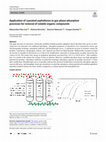
Chemical Papers, 2019
The paper presents an innovative, chemically modified (methylcyanated) asphaltene-based adsorbent... more The paper presents an innovative, chemically modified (methylcyanated) asphaltene-based adsorbent that can be an interesting low-cost alternative for traditional adsorbents. Adsorption properties of adsorbents were examined by inverse gas chromatography technique, adsorption isotherms, and breakthrough curves. A significant increase in retention volume for pyridine, 2-pentanone, nitropropane, toluene, and 1-butanol was observed. Rohrschneider–McReynolds constants revealed an increase in strength of interactions as a result of the modification, especially in strong proton–acceptor interaction (by a factor of 4.6). The surface-free energy of asphaltene adsorbents increased from 136.71 to 169.95 mJ m−2 after modification. It is similar to the surface-free energy of silica or alumina. Moreover, modified adsorbent shows very high adsorption potential for pyridine. Adsorption isotherms revealed that monolayer adsorption capacity for pyridine increased 1.5 times after modification. Breakth...
Journal of Chromatography A, 2018
deep eutectic solvents as "green" extraction media for polycyclic aromatic hydrocarbons in aqueou... more deep eutectic solvents as "green" extraction media for polycyclic aromatic hydrocarbons in aqueous samples,

Ultrasonics sonochemistry, 2018
Cavitation has become on the most often applied methods in a number of industrial technologies. I... more Cavitation has become on the most often applied methods in a number of industrial technologies. In the case of oxidation of organic pollutants occurring in the aqueous medium, cavitation forms the basis of numerous advanced oxidation processes (AOPs). This paper presents the results of investigations on the efficiency of oxidation of the following groups of organic compounds: organosulfur, nitro derivatives of benzene, BTEX, and phenol and its derivatives in a basic model effluent using hydrodynamic and acoustic cavitation combined with external oxidants, i.e., hydrogen peroxide, ozone and peroxone. The studies revealed that the combination of cavitation with additional oxidants allows 100% oxidation of the investigated model compounds. However, individual treatments differed with respect to the rate of degradation. Hydrodynamic cavitation aided by peroxone was found to be the most effective treatment (100% oxidation of all the investigated compounds in 60 min). When using hydrodyna...
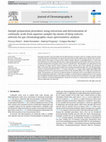
Journal of chromatography. A, Jan 22, 2018
The paper presents a new procedure for the determination of organic acids in a complex aqueous ma... more The paper presents a new procedure for the determination of organic acids in a complex aqueous matrix using ultrasound-assisted dispersive liquid-liquid microextraction followed by injection port derivatization and GC-MS analysis. A deep eutectic solvent (choline chloride: 4-methylphenol in a 1:2 mol ratio) was used both as an extracting solvent and as a derivatizing agent to yield ion pairs which were next converted to methyl esters of organic acids in a hot GC injection port. The procedure was optimized in terms of selection of a deep eutectic solvent, disperser solvent, and the ratio of their volumes, pH, salting out effect, extraction time, injection port temperature and time of opening the split valve. The developed procedure is characterized by low LOD (1.7-8.3 μg/L) and LOQ (5.1-25 μg/L) values, good repeatability (RSD ranging from 4.0 to 6.7%), good recoveries for most of the studied analyte (81,5-106%) and a wide linear range. The procedure was used for the determination of...

Ultrasonics Sonochemistry, 2018
Utilization of cavitation in advanced oxidation processes (AOPs) is a promising trend in research... more Utilization of cavitation in advanced oxidation processes (AOPs) is a promising trend in research on treatment of industrial effluents. The paper presents the results of investigations on the use of hydrodynamic cavitation aided by additional oxidation processes (O 3 /H 2 O 2 /Peroxone) to reduce the total pollution load in the effluent from the production of bitumens. A detailed analysis of changes in content of volatile organic compounds (VOCs) for all processes studied was also performed. The studies revealed that the most effective treatment process involves hydrodynamic cavitation aided by ozonation (40% COD reduction and 50% BOD reduction). The other processes investigated (hydrodynamic cavitation + H 2 O 2 , hydrodynamic cavitation + Peroxone and hydrodynamic cavitation alone) ensure reduction of COD by 20, 25 and 13% and reduction of BOD by 49, 32 and 18%, respectively. The results of this research revealed that most of the VOCs studied are effectively degraded. The formation of byproducts is one of the aspects that must be considered in evaluation of the AOPs studied. This work confirmed that furfural is one of the byproducts whose concentration increased during treatment by hydrodynamic cavitation alone as well as hydrodynamic cavitation aided by H 2 O 2 as an external oxidant and it should be controlled during treatment processes.
Chemical Engineering Journal, 2017
Advanced oxidation processes (AOPs) have been used as an alternative and effective option for tre... more Advanced oxidation processes (AOPs) have been used as an alternative and effective option for treatment of industrial wastewater, especially in the case of the non-biodegradable compounds. Despite of several well developed AOPs, the majority of them are effective only at acidic or neutral pH, namely Fenton related processes, making the list of available effective advanced oxidation technologies strongly limited. In many cases, industrial effluents are formed at basic pH conditions. This paper reviews the state of the art of AOPs exclusively at alkaline pH, the type of compounds and effluents effectively degraded, the influence of pH on the efficiency of the processes, economic evaluation and degradation pathways. Spent caustic, polyester and acetate fiber dye effluents, phenol, acidic and sulfur based compounds, specific dyes and drugs
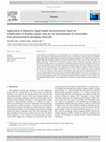
Journal of separation science, 2016
We present a new procedure for the determination of oxygenated volatile organic compounds in samp... more We present a new procedure for the determination of oxygenated volatile organic compounds in samples of postoxidative effluents from the production of petroleum bitumens using dispersive liquid-liquid microextraction and gas chromatography with mass spectrometry. The eight extraction parameters were optimized for 43 oxygenated volatile organic compounds. The detection limits obtained ranged from 0.07 to 0.82 μg/mL for most of the analytes, the precision was good (relative standard deviation below 2.91% at the 5 μg/mL level and 4.75% at the limit of quantification), the recoveries for the majority of compounds varied from 70.6 to 118.9%, and the linear range was wide, which demonstrates the usefulness of the procedure. The developed procedure was used for the determination of oxygenated volatile organic compounds in samples of raw postoxidative effluents and in effluents after chemical treatment. In total, 23 compounds at concentration levels from 0.37 to 32.95 μg/mL were identified ...
Waste and Biomass Valorization, 2017

Journal of separation science, Jan 6, 2017
We present a new procedure for the determination of 32 volatile organonitrogen compounds in sampl... more We present a new procedure for the determination of 32 volatile organonitrogen compounds in samples of industrial effluents with a complex matrix. The procedure, based on dispersive liquid-liquid microextraction followed by gas chromatography with nitrogen-phosphorus and mass spectrometric detection, was optimized and validated. Optimization of the extraction included the type of extraction and disperser solvent, disperser solvent volume, pH, salting out effect, extraction, and centrifugation time. The procedure based on nitrogen-phosphorus detection was found to be superior, having lower limits of detection (0.0067-2.29 μg/mL) and quantitation as well as a wider linear range. The developed procedure was applied to the determination of content of volatile organonitrogen compounds in samples of raw effluents from the production of bitumens in which 13 compounds were identified at concentrations ranging from 0.15 to 10.86 μg/mL and in samples of effluents treated by various chemical m...

Journal of Separation Science, 2016
A new method was established for the determination of the extractables from pharmaceutical packag... more A new method was established for the determination of the extractables from pharmaceutical packaging materials using dispersive liquid-liquid microextraction based on solidification of floating organic drop (DLLME-SFO) coupled with ultra-high-performance liquid chromatography quadrupole time-of-flight mass spectrometry (UHPLC-QTOF MS). Packaging samples were filled with three kinds of buffer solutions: acid buffer (pH = 3), alkaline buffer (pH = 9) and 0.9% NaCl solution to extract as many extractables as possible, and then the extractables in buffer solutions were enriched by DLLME-SFO technique. Parameters affecting the efficiency of the extraction procedure were evaluated and optimized, including the type and volume of dispersant, extractant volume, pH and vortex-mixing time. After optimization, the values obtained for limits of detection and quantification for three kinds of common antioxidants were 0.3 and 1.0 μg/L respectively, and good linearity (R 2 > 0.99) was observed in their respective concentration ranges. The recoveries ranged from 80.61% to 117.87% at three spiked levels with the relative standard deviations (RSDs) between 0.92% and 9.29% (n = 6) in all three buffer solutions. The developed method was successfully applied to the analysis of extractables from pharmaceutical packaging materials. The results indicated that the proposed procedure is a novel, sensitive, fast and repeatable method and has a great significance for evaluation of safety of pharmaceutical packaging materials.
Analytical Methods, 2016
The paper presents a new procedure for the determination of oxygenated volatile organic compounds... more The paper presents a new procedure for the determination of oxygenated volatile organic compounds in postoxidative effluents from the production of petroleum asphalt using dynamic headspace coupled to gas chromatography-mass spectrometry in SIM mode.
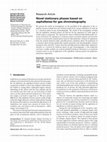
Journal of Separation Science, 2016
We present the results of investigations on the possibility of the application of the asphaltene ... more We present the results of investigations on the possibility of the application of the asphaltene fraction isolated from the oxidized residue from vacuum distillation of crude oil as a stationary phase for gas chromatography. The results of the investigation revealed that the asphaltene stationary phases can find use for the separation of a wide range of volatile organic compounds. The experimental values of Rohrschneider/McReynolds constants characterize the asphaltenes as stationary phases of medium polarity and selectivity similar to commercially available phases based on alkyl phthalates. Isolation of asphaltenes from the material obtained under controlled process conditions allows the production of a stationary phase having reproducible sorption properties and chromatographic columns having the same selectivity. Unique selectivity and high thermal stability make asphaltenes attractive as a material for stationary phases for gas chromatography. A low production cost from a readily available raw material (oxidized petroleum bitumens) is an important economic factor in case of application of the asphaltene stationary phases for preparative and process separations.
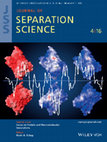
Journal of Separation Science, 2016
We present the results of investigations of the chromatographic (sorptive) properties of silanize... more We present the results of investigations of the chromatographic (sorptive) properties of silanized silica gel as a stationary phase for gas chromatography used for simulated distillation. Commercially available silanized sorbent (particle diameter range 63-200 m, average pore size 60 Å) was sieved to obtain the 80-100 mesh fraction (180-150 m). The obtained results revealed that silanized silica gel allows the complete separation of a mixture of nand iso-alkanes in the C 1-C 7 range. Such a separation is achieved with a temperature program starting with an initial temperature of 50˚C, which is advantageous because the gas chromatograph oven does not have to be cooled below room temperature. The use of temperature programming with a final temperature of 300˚C ensures separation and elution of all mixture components from C 1 to n-C 28 in one run. This study confirms the applicability of silanized silica gel as a stationary phase for the investigation of distillation temperature distribution of gasoline and diesel fuel based on the simulated distillation procedure according to ASTM D2887. The deviations of individual points of distillation curve obtained using ASTM D2887 and columns packed with silanized silica gel were within the reproducibility range of the standard procedure.

Road Materials and Pavement Design, 2015
This paper describes application of high-performance gel permeation/size-exclusion chromatography... more This paper describes application of high-performance gel permeation/size-exclusion chromatography (GPC/SEC) for the determination of content of polymer modifiers in modified road bitumens. The obtained results were compared with the measurements based on the procedure recommended by the American Association of State Highway and Transportation Officials, which employs Fourier transform mid-infrared spectroscopy. Two most commonly used modifiers of paving bitumens, namely, styrene–butadiene–styrene and styrene–butadiene copolymers as well as modified bitumens sampled from various streets in the city of Gdansk (Poland), were investigated. This work confirmed the ability of GPC/SEC to distinguish modified road bitumens from unmodified ones. The developed methodology is particularly important in quality control of modified bitumens, as well as in arbitration analysis when there is a suspicion that the amount of modifier added to bitumen was lowered or that the material does not meet the specifications concerning the modifier content. GRAPHICAL ABSTRACT




Uploads
Papers by Grzegorz Boczkaj